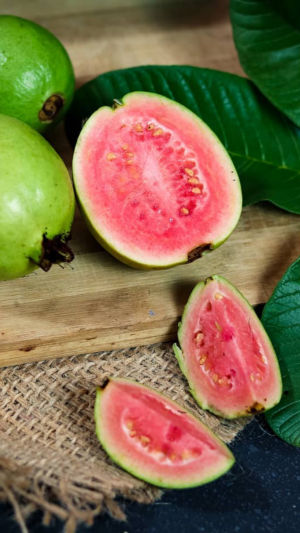Guava is a fruit with a delightful aroma and a mildly tangy taste. Although it may not be as sweet as some other fruits, it is known for its refreshing juiciness.
Many people are not very familiar with guava, but this fruit can be enjoyed in various ways. You can eat it raw, make it into jam, or even turn it into jelly.
These diverse preparations not only offer delicious flavors but also allow you to benefit from their nutritional value. Regular consumption of guava can provide your body with essential nutrients.
Guava is visually appealing, with ripe ones displaying a light green hue and thin, crispy skin. The fruit itself is crisp and seedless, resembling the flavors of dates and pears. This makes guava a convenient and tasty choice.
Guava is packed with a variety of nutrients, including vitamin C, protein, and dietary fiber. Consuming these substances can help prevent various nutrient deficiencies, making it a healthy choice.
The high fiber content in guava promotes overall intestinal metabolism, aiding digestion and preventing issues like constipation and colon cancer.
If you're aiming to shed some pounds, guava's abundant fiber can contribute to a feeling of fullness, making it a great addition to your weight loss plan.
Guava comes in two primary varieties: white heart and red heart. White heart guavas are sour, crunchy, and generally firm, while red heart guavas taste sweeter and more watermelon-like. They are even juicier and sweeter when fully ripe.
As part of a balanced diet, it's recommended to consume at least three different types of fruit per day. For guava, a maximum of 200 grams per day is advisable.
Red guava stands out for being both sweet and nutritious. It boasts a remarkable amount of vitamin C, about 40 times more than apples and eight times more than citrus fruits like lemons.
Additionally, it can help improve the body's immune system and contribute to better blood glucose control.
However, many people are unfamiliar with guava's characteristics. When buying guava, they often struggle to pick the right one and store it properly, leading to unripe or quickly spoiled purchases.
So, how can you select and store guava?
Guavas in the market come in various sizes and shapes, both round and elongated. Red heart guavas tend to have a stronger aroma, and larger ones are generally sweet with white hearts.
When choosing guava, consider the texture. Ripe guava should feel relatively hard and crisp in your hand, without a mushy or floating sensation. This indicates freshness.
Interestingly, the less attractive the outer appearance of guava, the better the flavor. So, don't be deterred by an unsightly appearance. If you buy greener-skinned guavas, allow them to ripen at home for a few days before consumption.





